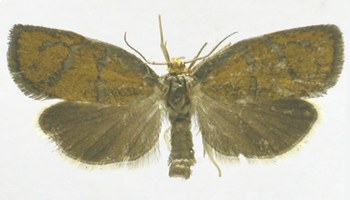Pests
Ptycholoma lecheana (Linnaeus) - Leche's Twist Moth
Systematic position.
Class Insecta, order Lepidoptera, family Tortricidae, subfamily Tortricinae, tribe Archipini, genus Ptycholoma. In Russian literature P. circumclusana Chr. distributed in the Far East is considered either synonym, or subspecies of nominative species.Synonyms.
Ptycholoma magnificana H.-S., Ptycholoma lecheana circumclusana Chr., Cacoecia circumslusana Chr.Biological group.
This is a polyphagous pest of cultural rosaceous crops and forest trees.Morphology and biology.
Fore wings dark golden-yellow (wingspan 15-20 mm), male wing with blackish costal out-fold. Black strokes gradually increase in size from base toward outer margin of wing. The wing base has two transversal stripes, and notum having lead color. Hind wings are black-brown, with lighter anterior margin; its fringe white. Eggs are oval, lenticular and yellow-green. Caterpillars of 1st instar yellow, eating ones are yellow-green, to 2 mm in length. Head and prothoracic scutellum light brown. Anal plate has the same color as body, bearing weak brown strokes. During their growth and development the caterpillars become more darkly painted. Pupae are 9-10 mm long, dark brown or black, with oval spiracles. Caterpillars of the 2nd and 3rd instars winter in dense white cocoons in bark cracks on trunks and branches, under leaves plaited to bark, and also under dry bud scales on branches. The over-wintered caterpillars gnaw around blossoming buds and plaited leaves at branch tips, and also plaited buds, flowers and ovaries. Summer caterpillars will skeletonize leaves, especially along veins, able to gnaw out short holes in fruits until wintering. Pupation occurs in feeding places or in crevices of trunks during apple fruit formation. Pupae develop over 10-12 days. Average fertility under laboratory conditions is about 160 eggs. Female lays 32-108 (50 on the average) eggs in batches (to 5-80 eggs in a batch). Eggs are laid on leaves along veins.Distribution.
The species is distributed in Western Europe from England to Turkey; China, Japan, Korea. In the former USSR the species is distributed in the European part (everywhere from Karelia to the Caucasus), in Transcaucasia, Ural, Kazakhstan, Southern Siberia, Transbaikalia, in the south of the Far East (Amur and Sakhalin Regions, Khabarovsk and Primorskii Territories, Kunashir and Shikotan).Ecology.
This species is everywhere monovoltine. Over-wintered caterpillars appear from winter cocoons in April or May, at average daily temperatures of 10°C and higher, during apple bud blossoming. Moths fly from the end of May until July. Mass flight occurs at the end of May and the beginning of June in the European part, in June in the Primorskii Territory. Moths are active from midday until sunset, in the beginning of night, and in the morning. Oviposition begins 2-3 days after the appearance of the female. Egg development lasts 6-7 days at temperatures of 22°C. Summer caterpillars hatch during the period of abscission of excess ovaries, usually from the end of July.Economic significance.
This is a significant pest in orchards of the south of the former USSR. Significant harm was found in the Krasnodar Territory. Polyphagous caterpillars damage all rosaceous fruit crops, especially apple and plum, and also oak, birch, linden, ash, elm, maple, poplar, willow, and other trees and bushes. In Siberia they can damage needles of larches. They are also found on ginseng.Control measures.
Agronomical measures include the cleaning of mortified bark, pruning old and diseased branches, disturbance of wintering caterpillars at tree root necks. Biological measures include the application of biological preparations. Chemical measures include local insecticide treatments during appearance of over-wintered caterpillars before flowering. Monitoring and forecast is possible with the use of pheromone traps.Reference citations:
Ermolaev V.P. 1988. Tortricidae. In: Kirpichnikova V.A., Ler P.A., eds. Butterflies - pests of agriculture in the Far East. Keys. Vladivostok: Biology and Soil Institute, DO AN SSSR. 65-99 p. (In Russian)Galetenko S.M. 1964. To morphology of fruit leafrollers. In: Kochkin M.A., Rubtsov N.I., Ryndin N.V., eds. 150 years to State Nikitskii botanical garden. Collection of scientific works. V. 37. Moscow: Kolos. 531-395 p. (In Russian)
Kostyuk Yu.A. 1974. Family Tortricidae. In: Vasil.ev V.P., ed. Pests of agricultural crops and forest plantations. V. 2. Arthropods. Kiev: Urozhai. 261-320 p. (In Russian)
Kostyuk Yu.A. 1980. Tortricidae. Issue 10. Tortricinae. In: Dolin V.G., ed. Fauna of Ukraine. V. 15. Kiev: Naukova dumka. 424 p. (In Ukrainian)
Kuznetsov V.I. 1994. Family Tortricidae. In: Kuznetsov V.I., ed. Insects and mites - pests of agricultural plants. V. 3(1). Lepidoptera. St. Petersburg: Nauka. 51-234 p. (In Russian)
Vasil.ev V.P., Livshits I.Z. 1984. Pests of fruit crops. Moscow: Kolos. 399 p. (In Russian)


